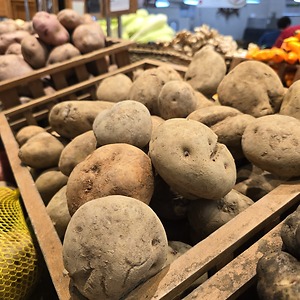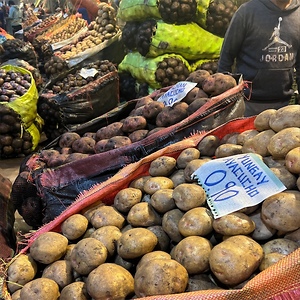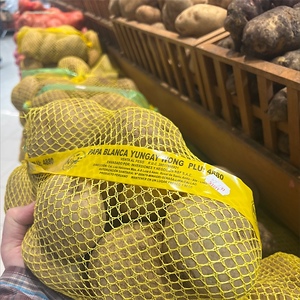


Blanca Yungay Potatoes
Estimated Inventory, lb : 0
Description/Taste
Blanca Yungay potatoes vary in size, depending on growing conditions, but generally average 9 to 11 centimeters in length and 8 to 9 centimeters in diameter. The tubers have a fairly uniform, oval shape and are flattened on one side with smooth, curved edges. Blanca Yungay potatoes are often covered in clay-like soils when sold in local markets. Once washed, the soil is removed, revealing semi-thick, light brown skin, ivory, to yellow skin. The skin is primarily taut, firm, and textured, enveloped in dark brown-black tiny spots, flecks, and small holes. There are also a few red-pink eyes scattered across the surface. These eyes are mostly shallow and do not affect the overall shape of the tuber. Underneath the surface, the flesh ranges in color from cream, almost white, to ivory shades with yellow tints. The flesh is firm and grainy when raw, becoming dense, slightly creamy, and tender when cooked. Blanca Yungay potatoes have a moderate starch and moisture content, allowing them to develop a versatile consistency for culinary preparations. When cooked, the variety has a mild, neutral, subtly sweet, and lightly earthy taste, lacking bitter nuances found in other types of white potatoes.
Seasons/Availability
Blanca Yungay potatoes are available year-round, with peak production during the dry season from May through October.
Current Facts
Blanca Yungay potatoes, botanically classified as Solanum tuberosum, are a Peruvian variety belonging to the Solanaceae or nightshade family. The late-maturing hybrid was developed by breeders at the International Potato Center in Lima, Peru, in the late 20th century and was released as an improved commercial cultivar. Blanca Yungay potatoes are a type of white potato known as Papa Blanca in Spanish and have become one of the most widespread varieties sold in markets throughout Peru. The variety is known for its long growing season, resistance to some diseases and pests, and high yields, producing between 15 to 30 tubers per plant each season. Blanca Yungay potatoes can also be grown at high altitudes and are hardy, surviving in regions of drought, light frost, and poor soil. Since their release, Blanca Yungay potatoes have become a choice variety for Peruvian growers and are marketed as all-purpose tubers in commercial markets. The variety has a neutral but rich flavor, allowing them to be used in various savory, cooked preparations.
Nutritional Value
Blanca Yungay potatoes have not been extensively studied for their nutritional properties. Like other varieties of white potatoes, Blanca Yungay may be a source of fiber to regulate the digestive tract, magnesium to control nerve functions, potassium to balance fluid levels within the body, and vitamin C to strengthen the immune system. White potatoes may also provide some manganese to form connective tissues, folate to help break down certain amino acids, phosphorus to build bones and teeth, and other nutrients, including low amounts of calcium, vitamin K, iron, and zinc.
Applications
Blanca Yungay potatoes have a mild, subtly sweet, neutral taste suited for cooked preparations. The variety is marketed as “all-purpose,” meaning it has a blend of waxy and starchy potato qualities. All-purpose potatoes can be used in any recipe calling for white potatoes and the tubers have moderate starch levels, allowing the flesh to hold its shape, combined with moderate moisture levels, creating a tender, creamy consistency. Blanca Yungay potatoes are prevalent throughout Peruvian commercial markets and are typically purchased as a staple variety for everyday cooking. The potatoes can be sliced and prepared into French fries, developing a fluffy consistency, or roasted and mixed with vegetables and onions as a side dish. In Lima, Peru, Blanca Yungay potatoes are boiled and slathered in ocopa, a fragrant sauce of huacatay, garlic, aji amarillo chile peppers, milk, and onions. The potatoes can also be filled with meats, cheeses, and grains in papa rellena, or “stuffed potato,” and are added into various soups and stews, including chupe de camarones, a Peruvian-style shrimp chowder. In the Mercado No. 2 in Surquillo, a district within Lima, Blanca Yungay potatoes are often used in patita con mani, an Afro-Peruvian dish of pork with aromatics, potatoes, and peanuts mixed into a rich tomato, herb, and spice-filled sauce. Huerta Chinen, a restaurant within the Mercado No. 2, serves patita con mani with Blanca Yungay potatoes and is also known for mixing unusual flavors with potatoes to create innovative combination dishes. Blanca Yungay potatoes pair well with herbs such as bay leaves, oregano, cilantro, and parsley, aromatics including garlic, onions, and chile peppers, lime juice, artichokes, fish, meats such as pork, beef, and poultry, and queso fresco. Whole, unwashed Blanca Yungay potatoes will keep for several months when stored in a cool, dry, and dark location.
Ethnic/Cultural Info
Blanca Yungay potatoes were bred by Carlos Ochoa, a well-known Peruvian plant explorer, potato breeder, expert, and scientist. Ochoa spent his childhood in Cusco, Peru, and later studied agriculture in Cochabamba, Bolivia, and at the University of Minnesota in the United States. After his studies, Ochoa began to concentrate on the history and cultivation of potatoes, as he saw the importance of studying and advancing an essential native crop of Peru. Ochoa began developing potato breeding programs in 1947 and stressed cataloging and promoting the diversity of the tubers as a professor emeritus at the Universidad Nacional Agraria La Molina in Peru. Throughout his career, through various sources, Ochoa was known to collect wild potato species and study them in their natural mountainous habitats. It is said he found over 70 new species and rediscovered around 15 additional species. He also spent many years breeding new varieties at the International Potato Center, crossing Peruvian potatoes with European and other American cultivars to create hybrid potatoes with improved commercial cultivation characteristics. Blanca Yungay potatoes were one of Ochoa’s most notable releases, along with Tomasa Condemayta and Renacimineto varieties. Carlos Ochoa passed away at the age of 79 in Lima, Peru in 2008, but his legacy has remained throughout Peruvian commercial markets through Blanca Yungay potatoes.
Geography/History
Blanca Yungay potatoes were developed in Lima, Peru, through the International Potato Center, also known as CIP, a research and breeding facility. The variety was bred by potato expert Carlos Ochoa in 1970 and was created from multiple crosses between native Peruvian, Chilean, American, and European potato varieties. Blanca Yungay potatoes are said to be the product of crosses between Saskia and Earline potatoes, Hugaline and Renacimiento potatoes, and a final cross between the products of these crosses. The new hybrid variety was initially known as KB-103 and was later named Yungay, a name derived from a region in Peru. Around the same time as the potato’s commercial release, a town called Yungay in northern Peru was devastated by a landslide and flood on May 31, 1970, created by the Ancash earthquake. The occurrence killed over 20,000 people within Yungay, and the region was not rebuilt and left as a memorial in remembrance of the lives lost. Blanca Yungay potatoes were named to honor the Yungay victims of the 1970 natural disaster. The other descriptor in the name, blanca, translates to “white,” a nod to the tuber’s pale flesh coloring. When Blanca Yungay potatoes were initially released to commercial growers, they were often overlooked due to their long growing season. The variety was later studied and evaluated in trial fields across Peru and was found to produce some of the highest yields of modern commercial potatoes, increasing their popularity among growers. It was also favored for its hardiness and overall positive commercial traits. Today, Blanca Yungay potatoes are a widespread commercial variety throughout Peru and are common in local markets as an all-purpose variety. The variety is frequently grown near the cities of Huancavelica, Ayacucho, Junín, and Huánuco and was also exported to northern Brazil as a commercial variety. The Blanca Yungay potatoes featured in the photograph above were sourced through local markets throughout the districts of Surquillo and Miraflores in Lima, Peru.










